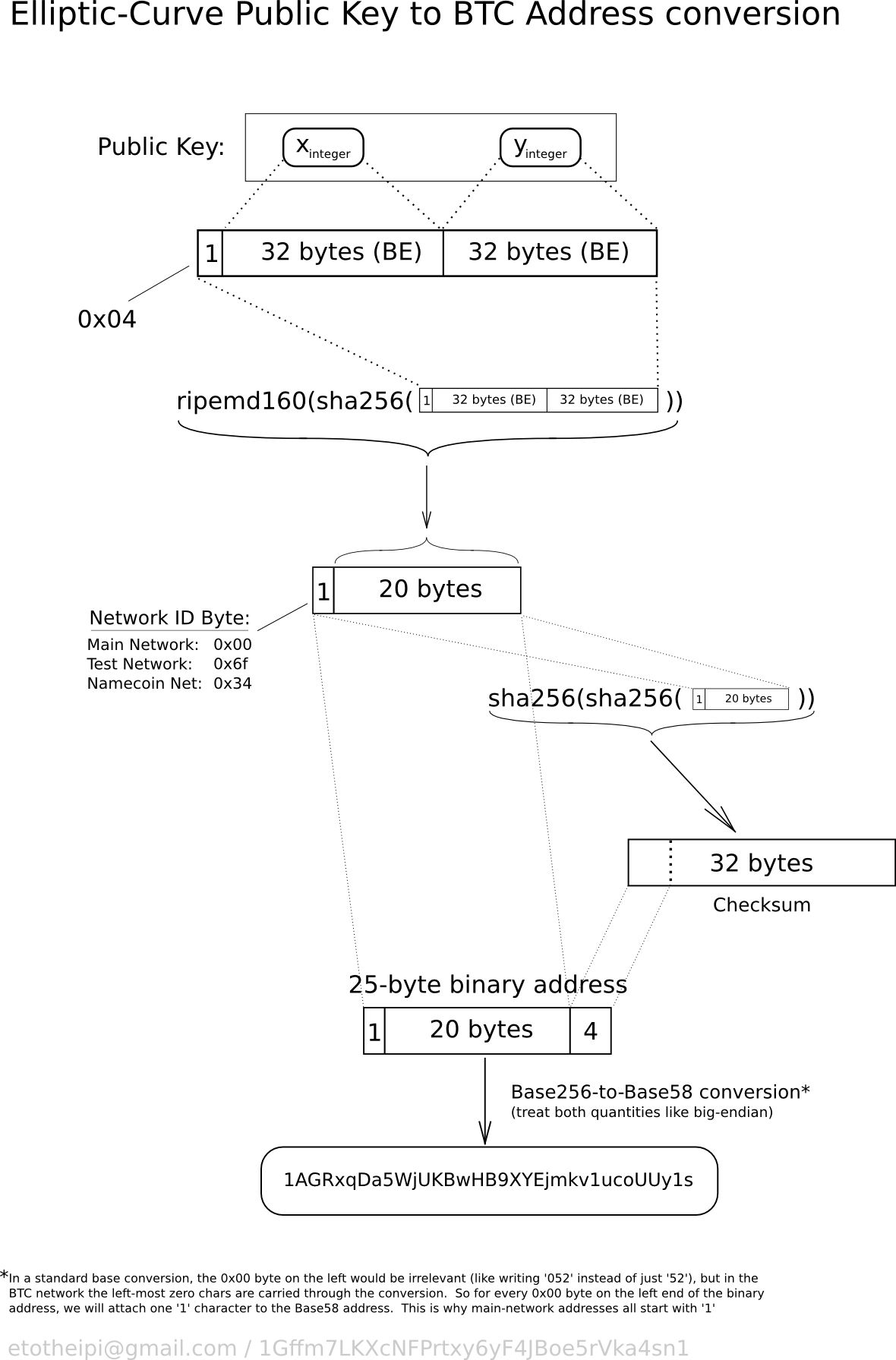Technical background of version 1 Bitcoin addresses

This article may be too technical for some users. The more basic article on Bitcoin Addresses may be more appropriate.
A Bitcoin address is a 160-bit hash of the public portion of a public/private ECDSA keypair. Using some mathemagic, you can "sign" data with your private key and anyone who knows your public key can verify that the signature is valid. See the Wikipedia article for more information about how this works.
A new keypair is generated for each receiving address. Bitcoin addresses (the public keys) and their associated private keys are stored in the wallet data file. This is the only file you need to back up. A "send" transaction to a specific Bitcoin address requires that the corresponding private key exist in the recipient's wallet. This has the implication that if you create a receiving address and receive coins to that address, then restore the wallet from an earlier backup, before the address was generated, then the coins associated with that address are lost. Addresses are added to an address key pool prior to being used for receiving coins. If you lose your wallet entirely, all of your coins are lost and can never be recovered.
"Generate" transactions happen in the same way as a send transaction: each batch of 50 generated coins is "sent" to a unique address that you generate just for that purpose. These addresses are also stored in your wallet, but they are not shown in the "your receiving addresses" section.
Bitcoin allows you to create as many addresses as you want, and each one is completely separate. There is no "master address": the "Your Bitcoin address" area in the Bitcoin UI has no special importance. It's only there for your convenience, and it will change automatically from time to time to enhance your anonymity. All of your other addresses will continue to work forever. They're listed in the "your receiving addresses" section. Each address takes up only about 500 bytes, so having a large number of addresses in your wallet is generally not a problem.
Bitcoin addresses contain a built-in check code, so it's generally not possible to send Bitcoins to a mistyped address. However, if the address is well-formed but no one owns it (or the owner lost their wallet.dat), any coins sent to that address will be lost forever.
Hash values and the checksum data are converted to an alpha-numeric representation using a custom scheme: the Base58Check encoding scheme. Under Base58Check, addresses can contain all alphanumeric characters except 0, O, I, and l. Normal addresses currently always start with 1, though this might change in a future version. Testnet addresses usually start with m or n. Mainline addresses can be 25-34 characters in length, and testnet addresses can be 26-34 characters in length. Most addresses are 33 or 34 characters long.
It is also possible to send Bitcoins directly to an IP address but this method is never recommended as a man-in-the-middle attacks makes redirecting coins trivial.
Since Bitcoin addresses are basically random numbers, it is possible, although extremely unlikely, for two people to independently generate the same address. This is called a collision. If this happens, then both the original owner of the address and the colliding owner could spend money sent to that address. It would not be possible for the colliding person to spend the original owner's entire wallet (or vice versa). If you were to intentionally try to make a collision, it would currently take 2^107 times longer to generate a colliding Bitcoin address than to generate a block. As long as the signing and hashing algorithms remain cryptographically strong, it will likely always be more profitable to collect generations and transaction fees than to try to create collisions.
How to create Bitcoin Address
0 - Having a private ECDSA key
18E14A7B6A307F426A94F8114701E7C8E774E7F9A47E2C2035DB29A206321725
1 - Take the corresponding public key generated with it (65 bytes, 1 byte 0x04, 32 bytes corresponding to X coordinate, 32 bytes corresponding to Y coordinate)
0450863AD64A87AE8A2FE83C1AF1A8403CB53F53E486D8511DAD8A04887E5B23522CD470243453A299FA9E77237716103ABC11A1DF38855ED6F2EE187E9C582BA6
2 - Perform SHA-256 hashing on the public key
600FFE422B4E00731A59557A5CCA46CC183944191006324A447BDB2D98D4B408
3 - Perform RIPEMD-160 hashing on the result of SHA-256
010966776006953D5567439E5E39F86A0D273BEE
4 - Add network byte in front of RIPEMD-160 hash (0x00 for Main Network)
00010966776006953D5567439E5E39F86A0D273BEE
5 - Perform SHA-256 hash on the extended RIPEMD-160 result
445C7A8007A93D8733188288BB320A8FE2DEBD2AE1B47F0F50BC10BAE845C094
6 - Perform SHA-256 hash on the result of the previous SHA-256 hash
D61967F63C7DD183914A4AE452C9F6AD5D462CE3D277798075B107615C1A8A30
7 - Take the first 4 bytes of the second SHA-256 hash. This is the address checksum
D61967F6
8 - Add the 4 checksum bytes from point 7 at the end of extended RIPEMD-160 hash from point 4. This is the 25-byte binary Bitcoin Address.
00010966776006953D5567439E5E39F86A0D273BEED61967F6
9 - Convert the result from a byte string into a base58 string using Base58Check encoding. This is the most commonly used Bitcoin Address format
16UwLL9Risc3QfPqBUvKofHmBQ7wMtjvM